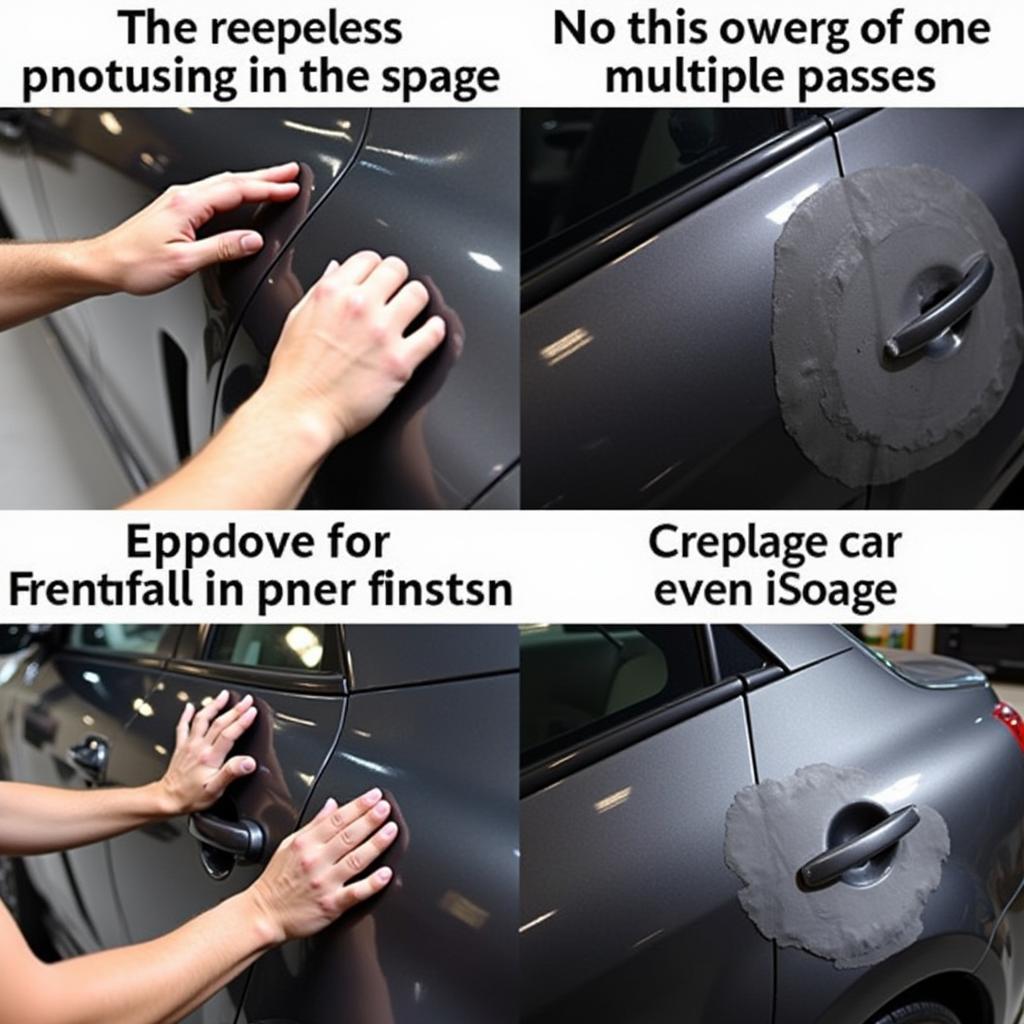A “pass” in car detailing refers to a single, complete application of a product or tool over a specific area of a vehicle. It’s a fundamental concept in detailing, impacting the effectiveness of the process and the final finish. Understanding what constitutes a pass ensures consistent results and prevents issues like uneven application or product overuse. Let’s explore this seemingly simple yet crucial element of car detailing in more depth. Want to learn how to efficiently detail a car? Click how to efficiently detail a car.
Understanding the Concept of a Pass
A pass isn’t just a haphazard swipe across the car. It’s a deliberate and methodical application, whether you’re polishing paint, applying sealant, or even vacuuming the interior. The number of passes required depends on the product, the tool used, and the desired outcome. For example, applying a wax might only require one or two passes, while polishing out a scratch could take several more.
Why are Passes Important?
Multiple passes are often necessary to achieve optimal results. This allows the product to work effectively, whether it’s a polish abrading the paint or a sealant bonding to the surface. Too few passes can lead to uneven coverage and subpar results. Conversely, excessive passes can be counterproductive, wasting product and potentially damaging the surface.
 Multiple Passes with Car Polish
Multiple Passes with Car Polish
Different Types of Passes in Detailing
Different detailing tasks call for varying approaches to passes. Let’s examine a few examples:
-
Polishing: When polishing, multiple passes are essential. Initial passes cut away imperfections, while subsequent passes refine the finish. The number and type of passes depend on the severity of the imperfections and the aggressiveness of the polish. Learning how to start a car detailing shop involves mastering this skill. Find out more here: how to start a car detailing shop.
-
Waxing/Sealing: Applying wax or sealant usually requires fewer passes. A thin, even layer is key, and too many passes can lead to streaking or clumping.
-
Interior Detailing: Even vacuuming involves the concept of passes. Overlapping passes ensure thorough cleaning and pick up all dirt and debris.
How Many Passes are Enough?
The “right” number of passes is rarely a fixed number. It depends on various factors, including the product’s instructions, the condition of the surface, and the tools being used. Experience plays a significant role in determining the optimal number of passes.
Common Mistakes to Avoid
One common mistake is applying too much product on each pass. This can lead to uneven coverage and make it harder to buff off the product. Another mistake is not overlapping passes sufficiently, resulting in missed spots.
“Understanding the concept of a ‘pass’ is essential for any detailer, whether a seasoned professional or a weekend warrior,” says renowned detailing expert, David Miller. “It’s a seemingly small detail, but it has a huge impact on the final outcome.”
Achieving the Perfect Pass
The key to a perfect pass is consistency. Maintain consistent pressure, speed, and overlap to ensure even product application. Practicing on less visible areas can help you refine your technique.
Tips for Mastering Passes
-
Follow product instructions: Always refer to the manufacturer’s instructions for guidance on the recommended number of passes.
-
Start with fewer passes: It’s always better to start with fewer passes and add more if necessary. You can always add another pass, but it’s much harder to remove product that has been over-applied.
-
Overlap each pass: Overlap each pass by about 50% to ensure complete coverage.
“Consistency is key,” adds detailing specialist, Sarah Chen. “A consistent approach to your passes will lead to consistent results, giving you that professional-level finish every time.”
Conclusion
Understanding what a pass is in car detailing is crucial for achieving professional results. By mastering the technique of proper passes, you can ensure even product application, avoid common mistakes, and ultimately achieve a flawless finish. Want to know more about car loans? Explore our guide on how to find car loan details. So, next time you detail your car, remember the importance of the pass. It’s the key to unlocking the true potential of your detailing efforts.
FAQ
- What Is A Pass In Car Detailing? A pass is a single, complete application of a product or tool over a specific area.
- Why are passes important? Passes ensure even product application and optimal results.
- How many passes are needed? The number of passes depends on the product, tool, and desired outcome.
- What are common mistakes with passes? Applying too much product or not overlapping passes sufficiently.
- How can I improve my pass technique? Practice, consistent pressure and speed, and following product instructions.
- What happens if I don’t make enough passes? You may have uneven coverage and subpar results.
- What happens if I make too many passes? You can waste product and potentially damage the surface.
Do girls detail cars? Read our article why do girls not work at car dealerships as detailers. Also, how to note details cars for the MCAT can be found here: how to note details cars mcat.
Need help with car detailing? Contact us via WhatsApp: +1(641)206-8880, or Email: [email protected]. Our customer service team is available 24/7.

Leave a Reply